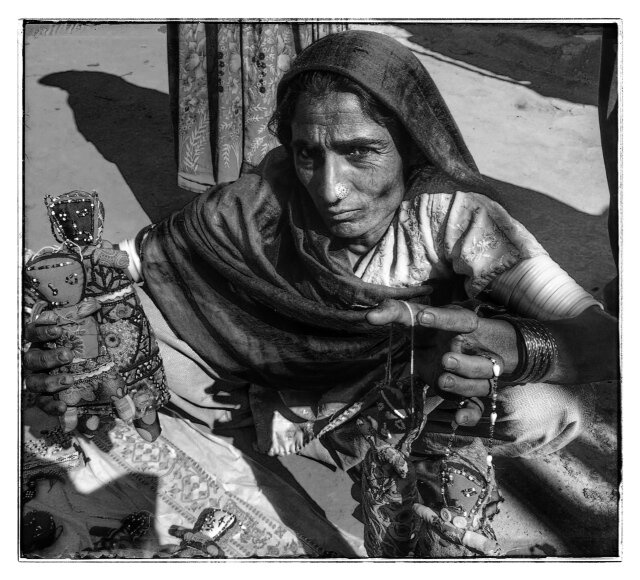The Gujarat Ten (Plus One Terrific Guy): Dusty, Determined and Dazzled
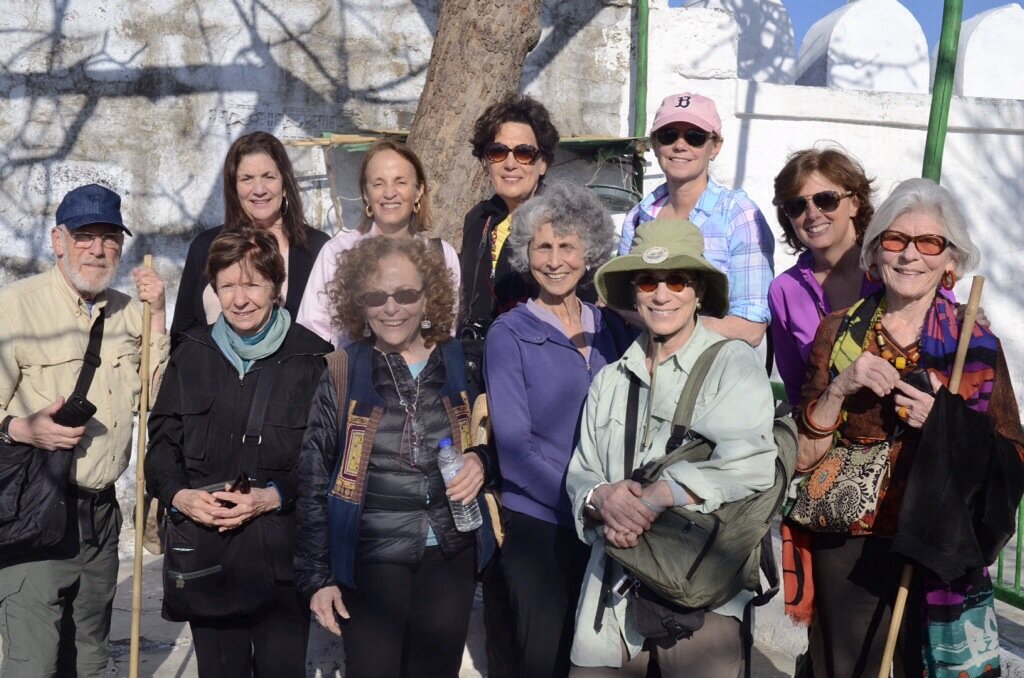 Nine other women and I came to India loosely united by the friendship or knowledge of an exceptional woman, Mary Ann Marino. Two of us were Mary Ann's longtime, dear friends, three of us only got to know her in the last years of her shining life, and one met her at dinner party at which Mary Ann shared her extraordinary story. The other four heard we were going to India to celebrate the life of a truly remarkable person and asked to come along. You can read more about Mary Ann in the February post of last year.Five of us had traveled in India previous to this trip and thought we knew what to expect. Three were seasoned travelers in other parts of the third world, one had been to Africa and mainland China, and the bravest (and, as it turned out, the pluckiest) of all was jumping off a virtual travel cliff, without the benefit of any travel experience beyond Europe's most civilized countries.We traveled in two vans that dodged water buffaloes, cows, camels, the occasional elephant, and frequent pot holes the size of jacuzzis. The roads, sometimes paved and often not, were always dusty. We were dusty. Conveniences that until now we took totally for granted, like hot water and the Internet, were unreliable or non-existent. 'Bathrooms' between hotel stops were, for the most part, typical third-world squat toilets. You don't come to India for gourmet cuisine - although we did have a few delicious meals - and we ate with care and crossed fingers that all would be well the next day. For a group that mostly didn't know each other before we began our trip I must say the chemistry was excellent. We all seemed to enjoy each others' company. There was never any whining or complaining, everyone was a very good sport and most important everyone was on time - to a fault. Our excellent teamwork made for a really terrific trip. Our rewards were many, including the new friends we made thanks to this most excellent adventure.In addition to two calm, cool, collected and occasionally daring drivers, we had the fortunate company of two very personable guides, each with his own area of expertise. As our schedule was jam-packed we benefitted from their gentle shepherding off and on the vans, in and out of villages, temples and other stops along the way. As we bumped and swerved over the primarily tabletop flat land, Vikram (our principal guide) supplied us with facts and background information while Chandrajee (his sidekick) charmed us with tidbits of local customs, including his upcoming wedding to which, he says, we will all be invited. I don't think there was one of us who could wrap her head around the fact, in keeping with the tradition of parent-arranged matches, he wasn't going to see his bride until they were married.I picked Gujarat a bit by accident. When we were in Hyderabad last year we met a woman at a dinner party who suggested with great enthusiasm that we spend the final month of our four month trip touring the famous weaving and handicraft villages of this western state that bumps out into the Indian Ocean directly south of Pakistan. I like looking at textiles and David lit up at the plan when he discovered that Palitana, a complex of Jain temple that he was determined to visit, was included on our itinerary. Then we checked the weather. We couldn't get to Gujarat until March, when average temperatures were a scorching 110-115 degrees F. It seemed we had missed the ideal season to go there last year. So, instead, we headed north to the Himalayas.However, I kept the extremely comprehensive and detailed itinerary our friend had provided last year. When Santha proposed the reunion of Mary Ann's friends on the anniversary of her death I wondered if a tour of weaving centers might appeal to the group coming from the States. It did and, as our tour ended at Palitana, David signed on to join us for the final few days.We assembled in Gujarat's capital city, Ahmedabad. Some of our group had spent the previous week traveling to other places in India, and some had just stepped off the plane onto Indian soil for the very first time. Ahmedabad is not the ideal gateway city for an India virgin visitor. There's not a lot of charm here. Traffic chaos reigns and the result is deadly gridlock at every intersection. There doesn't seem to be a real center of the city - just endlessly truck, car, tuk-tuk and cow-clogged streets clouded in a jarring cacophony of honking horns. It took such a long time to get anywhere it was almost time to leave as soon as we arrived.We all looked forward to visiting the famous Calico Museum of Textiles which, for many of us, was going to be a highlight of the trip. It turns out that tickets must be booked well in advance for the two daily tours that each accommodate only 20 people. Our tour operator who had made all the arrangements hadn't done this, so we were basically out of luck. Every string that could be pulled was pulled, but to no avail. Starting out with this major disappointment made me anxious about what lay ahead as I was the one who had talked everyone else into joining me on this great adventure.One salve for our disappointment was that our arrival coincided with an annual kite festival that is celebrated all over India.
Nine other women and I came to India loosely united by the friendship or knowledge of an exceptional woman, Mary Ann Marino. Two of us were Mary Ann's longtime, dear friends, three of us only got to know her in the last years of her shining life, and one met her at dinner party at which Mary Ann shared her extraordinary story. The other four heard we were going to India to celebrate the life of a truly remarkable person and asked to come along. You can read more about Mary Ann in the February post of last year.Five of us had traveled in India previous to this trip and thought we knew what to expect. Three were seasoned travelers in other parts of the third world, one had been to Africa and mainland China, and the bravest (and, as it turned out, the pluckiest) of all was jumping off a virtual travel cliff, without the benefit of any travel experience beyond Europe's most civilized countries.We traveled in two vans that dodged water buffaloes, cows, camels, the occasional elephant, and frequent pot holes the size of jacuzzis. The roads, sometimes paved and often not, were always dusty. We were dusty. Conveniences that until now we took totally for granted, like hot water and the Internet, were unreliable or non-existent. 'Bathrooms' between hotel stops were, for the most part, typical third-world squat toilets. You don't come to India for gourmet cuisine - although we did have a few delicious meals - and we ate with care and crossed fingers that all would be well the next day. For a group that mostly didn't know each other before we began our trip I must say the chemistry was excellent. We all seemed to enjoy each others' company. There was never any whining or complaining, everyone was a very good sport and most important everyone was on time - to a fault. Our excellent teamwork made for a really terrific trip. Our rewards were many, including the new friends we made thanks to this most excellent adventure.In addition to two calm, cool, collected and occasionally daring drivers, we had the fortunate company of two very personable guides, each with his own area of expertise. As our schedule was jam-packed we benefitted from their gentle shepherding off and on the vans, in and out of villages, temples and other stops along the way. As we bumped and swerved over the primarily tabletop flat land, Vikram (our principal guide) supplied us with facts and background information while Chandrajee (his sidekick) charmed us with tidbits of local customs, including his upcoming wedding to which, he says, we will all be invited. I don't think there was one of us who could wrap her head around the fact, in keeping with the tradition of parent-arranged matches, he wasn't going to see his bride until they were married.I picked Gujarat a bit by accident. When we were in Hyderabad last year we met a woman at a dinner party who suggested with great enthusiasm that we spend the final month of our four month trip touring the famous weaving and handicraft villages of this western state that bumps out into the Indian Ocean directly south of Pakistan. I like looking at textiles and David lit up at the plan when he discovered that Palitana, a complex of Jain temple that he was determined to visit, was included on our itinerary. Then we checked the weather. We couldn't get to Gujarat until March, when average temperatures were a scorching 110-115 degrees F. It seemed we had missed the ideal season to go there last year. So, instead, we headed north to the Himalayas.However, I kept the extremely comprehensive and detailed itinerary our friend had provided last year. When Santha proposed the reunion of Mary Ann's friends on the anniversary of her death I wondered if a tour of weaving centers might appeal to the group coming from the States. It did and, as our tour ended at Palitana, David signed on to join us for the final few days.We assembled in Gujarat's capital city, Ahmedabad. Some of our group had spent the previous week traveling to other places in India, and some had just stepped off the plane onto Indian soil for the very first time. Ahmedabad is not the ideal gateway city for an India virgin visitor. There's not a lot of charm here. Traffic chaos reigns and the result is deadly gridlock at every intersection. There doesn't seem to be a real center of the city - just endlessly truck, car, tuk-tuk and cow-clogged streets clouded in a jarring cacophony of honking horns. It took such a long time to get anywhere it was almost time to leave as soon as we arrived.We all looked forward to visiting the famous Calico Museum of Textiles which, for many of us, was going to be a highlight of the trip. It turns out that tickets must be booked well in advance for the two daily tours that each accommodate only 20 people. Our tour operator who had made all the arrangements hadn't done this, so we were basically out of luck. Every string that could be pulled was pulled, but to no avail. Starting out with this major disappointment made me anxious about what lay ahead as I was the one who had talked everyone else into joining me on this great adventure.One salve for our disappointment was that our arrival coincided with an annual kite festival that is celebrated all over India.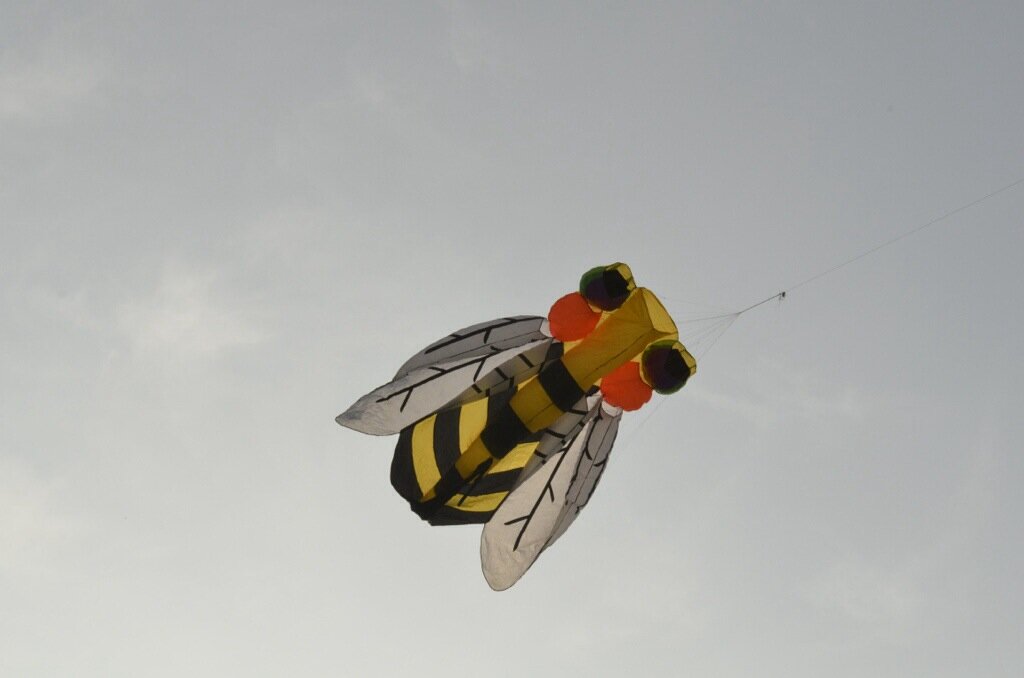 It was a joyous celebration where almost everyone from the smallest child to the oldest grandfather held onto the control end of a soaring kite, pulling the string to make the kite dive and soar. Many kites had glass or razors impregnated into the string and a facile operator could cut the string of any kite that his crossed paths with.We spent a few peaceful hours at the Gandhi Ashram which housed an extensive collection of memorabilia and photographs documenting this remarkable man's life. Quotes along with portraits of notable pacifists and people who challenged the system in non-violent ways were posted on the walls. The panel dedicated to Henry David Thoreau demonstrated how very far Ahmedabad is from Concord when I tried to explain to one or our guides that I often walk for exercise around the pond where Thoreau lived while he wrote his famous book. "What is your destination?" he asked. "Just around the pond," I told him. This didn't compute. It was clear that walking around a pond for exercise was an indulgence right up there with car seats and designer dogs. I felt, not for the first or last time, like the wildly pampered westerner that I am.
It was a joyous celebration where almost everyone from the smallest child to the oldest grandfather held onto the control end of a soaring kite, pulling the string to make the kite dive and soar. Many kites had glass or razors impregnated into the string and a facile operator could cut the string of any kite that his crossed paths with.We spent a few peaceful hours at the Gandhi Ashram which housed an extensive collection of memorabilia and photographs documenting this remarkable man's life. Quotes along with portraits of notable pacifists and people who challenged the system in non-violent ways were posted on the walls. The panel dedicated to Henry David Thoreau demonstrated how very far Ahmedabad is from Concord when I tried to explain to one or our guides that I often walk for exercise around the pond where Thoreau lived while he wrote his famous book. "What is your destination?" he asked. "Just around the pond," I told him. This didn't compute. It was clear that walking around a pond for exercise was an indulgence right up there with car seats and designer dogs. I felt, not for the first or last time, like the wildly pampered westerner that I am.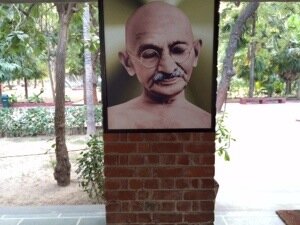 In our way out of town we stopped at the Rani Ki Vav stepwell, a UNESCO World Heritage site. The Rani-ki-Vav is situated about 2 km to the northwest of Patan district of Gujarat. It is the most magnificent stepwell in Gujarat, built during 11-12th centuries. The structure was constructed around a stepped corridor that was compartmented at regular intervals with pillared multi-storyed pavilions. Each of the four pavilions, which demarcate the stages along the descent, have multiple storys - two, four, six and seven respectively. Sculptures of deities and other images adorn the walls flanking the staircase. Nearly four hundred niches on the walls display images.The sight, and the light were especially wonderful.
In our way out of town we stopped at the Rani Ki Vav stepwell, a UNESCO World Heritage site. The Rani-ki-Vav is situated about 2 km to the northwest of Patan district of Gujarat. It is the most magnificent stepwell in Gujarat, built during 11-12th centuries. The structure was constructed around a stepped corridor that was compartmented at regular intervals with pillared multi-storyed pavilions. Each of the four pavilions, which demarcate the stages along the descent, have multiple storys - two, four, six and seven respectively. Sculptures of deities and other images adorn the walls flanking the staircase. Nearly four hundred niches on the walls display images.The sight, and the light were especially wonderful.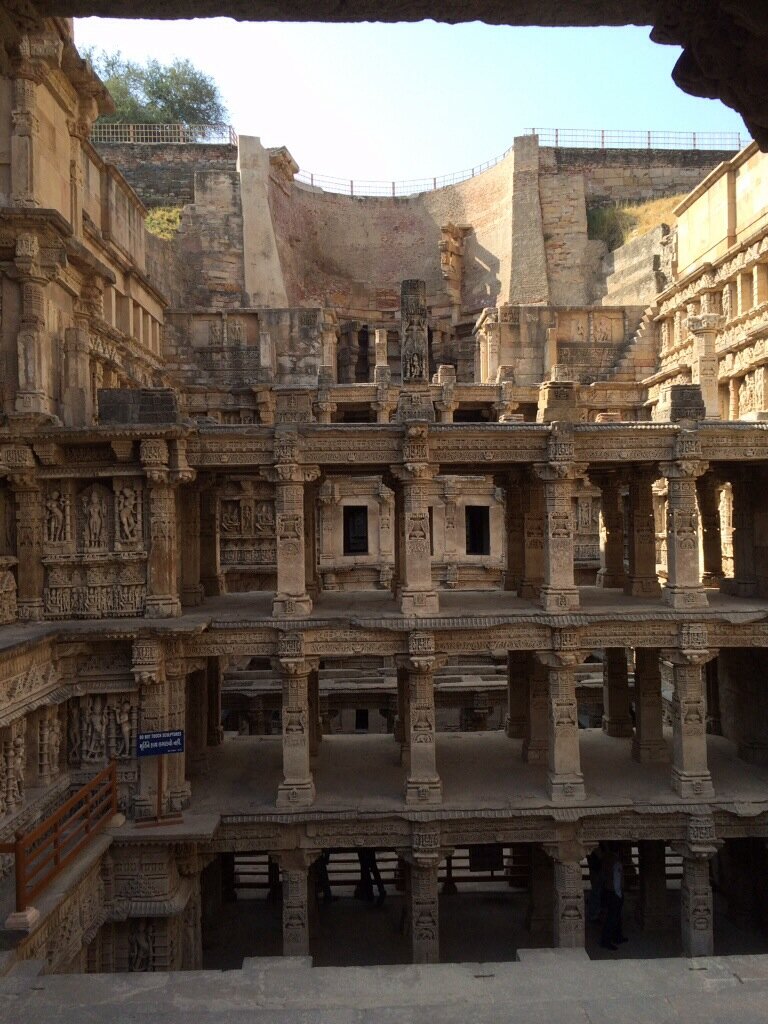
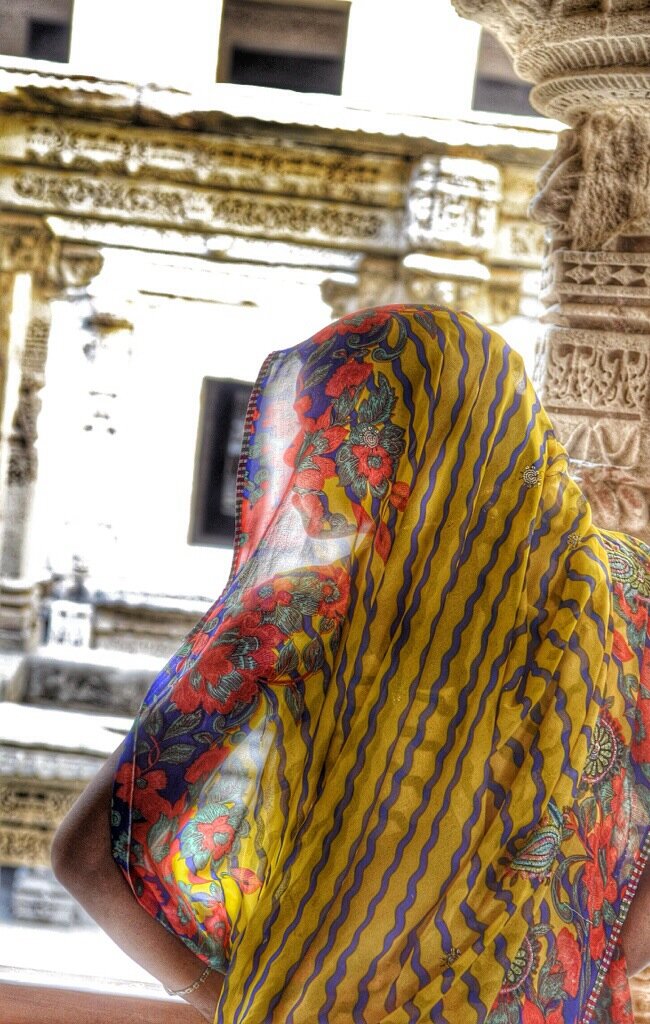 While Gujarat is one of India's poorer states, it is by far the richest in terms of exquisite handcrafted things, made following traditions that have been passed down for generations. Villages are remote, far from each other and often located at the end of narrow tracts that look more like alleys than streets. Most of the places we visited appeared dramatically poor, especially as viewed by western eyes. Water is carried from communal wells in metal containers balanced on the heads of women who somehow manage to walk gracefully and quickly from well to home.
While Gujarat is one of India's poorer states, it is by far the richest in terms of exquisite handcrafted things, made following traditions that have been passed down for generations. Villages are remote, far from each other and often located at the end of narrow tracts that look more like alleys than streets. Most of the places we visited appeared dramatically poor, especially as viewed by western eyes. Water is carried from communal wells in metal containers balanced on the heads of women who somehow manage to walk gracefully and quickly from well to home.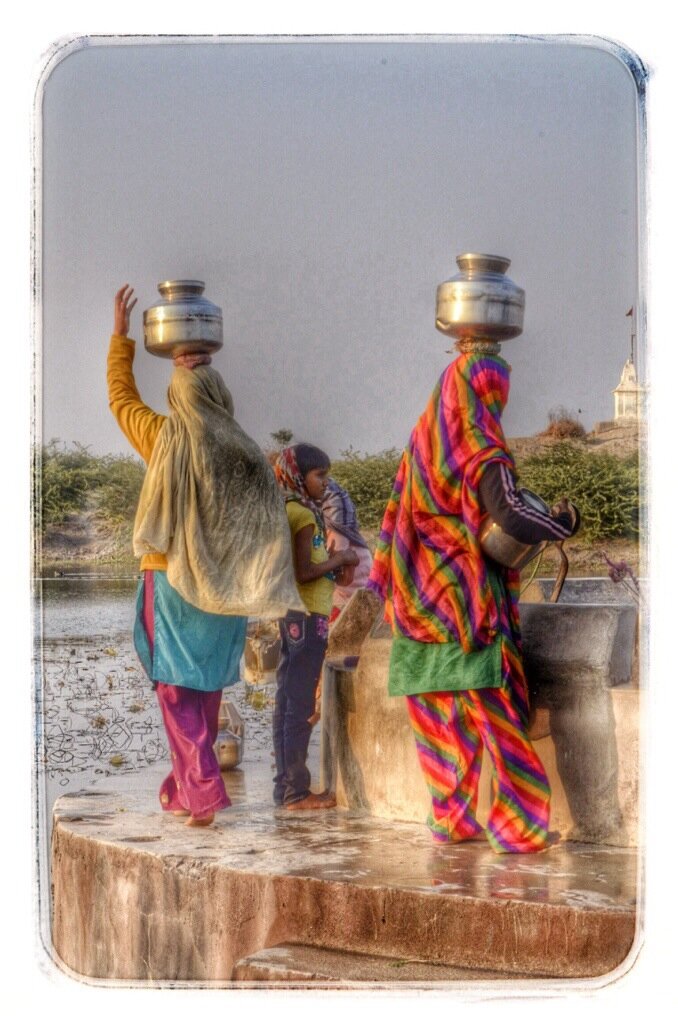 While there are some children obviously well cared far (clean, wearing school uniforms and shoes), others are barefoot, tassel haired, street-wise kids who don't appear to go to school. Instead they sit alongside a family member hawking bangles, earrings, beads and the like.
While there are some children obviously well cared far (clean, wearing school uniforms and shoes), others are barefoot, tassel haired, street-wise kids who don't appear to go to school. Instead they sit alongside a family member hawking bangles, earrings, beads and the like.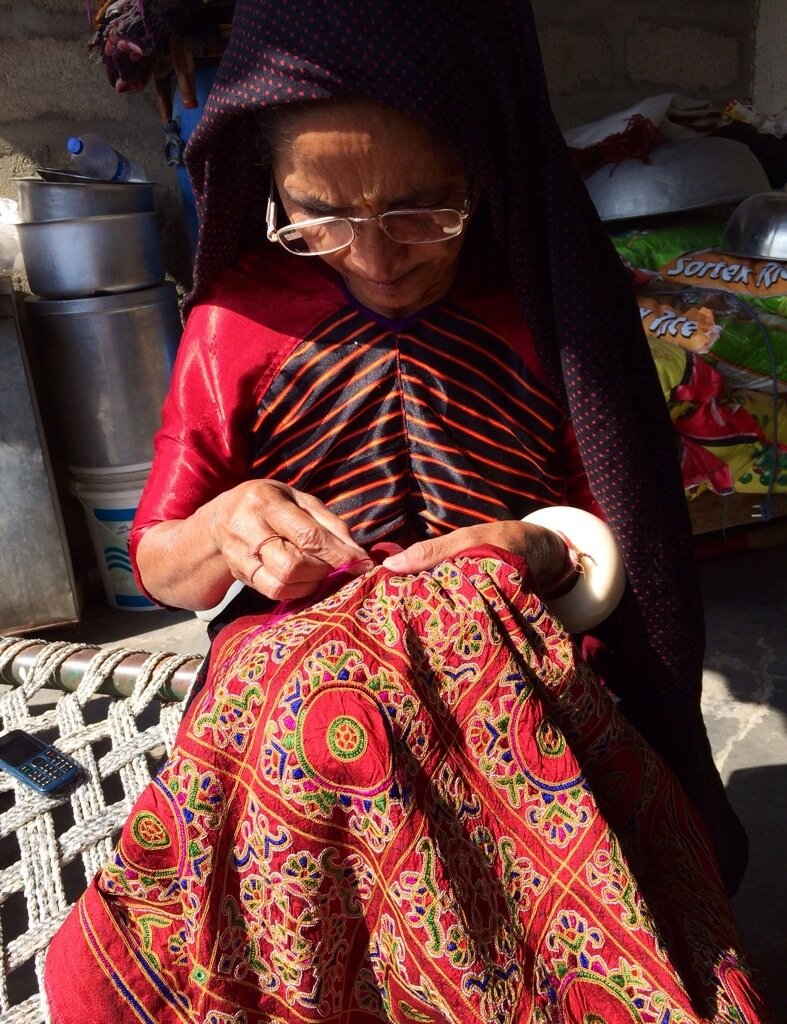 One result of this tour is that I will never again look at a piece of fabric or article of clothing without thinking about whose hands have worked to turn it from a silk worm thread or tuft of sheep's wool or seedy cotton puff into what I am now holding. Humbling and mind-boggling are words that come to mind as I watched women sewing tiny, precise stitches into purses and shawls. Unbelievable is the only word that can describe the seven stage process in which workers apply intricate stamps of hand carved teak to lengths of silk and cotton to create panels of complicated tie dye and dazzling batik.
One result of this tour is that I will never again look at a piece of fabric or article of clothing without thinking about whose hands have worked to turn it from a silk worm thread or tuft of sheep's wool or seedy cotton puff into what I am now holding. Humbling and mind-boggling are words that come to mind as I watched women sewing tiny, precise stitches into purses and shawls. Unbelievable is the only word that can describe the seven stage process in which workers apply intricate stamps of hand carved teak to lengths of silk and cotton to create panels of complicated tie dye and dazzling batik.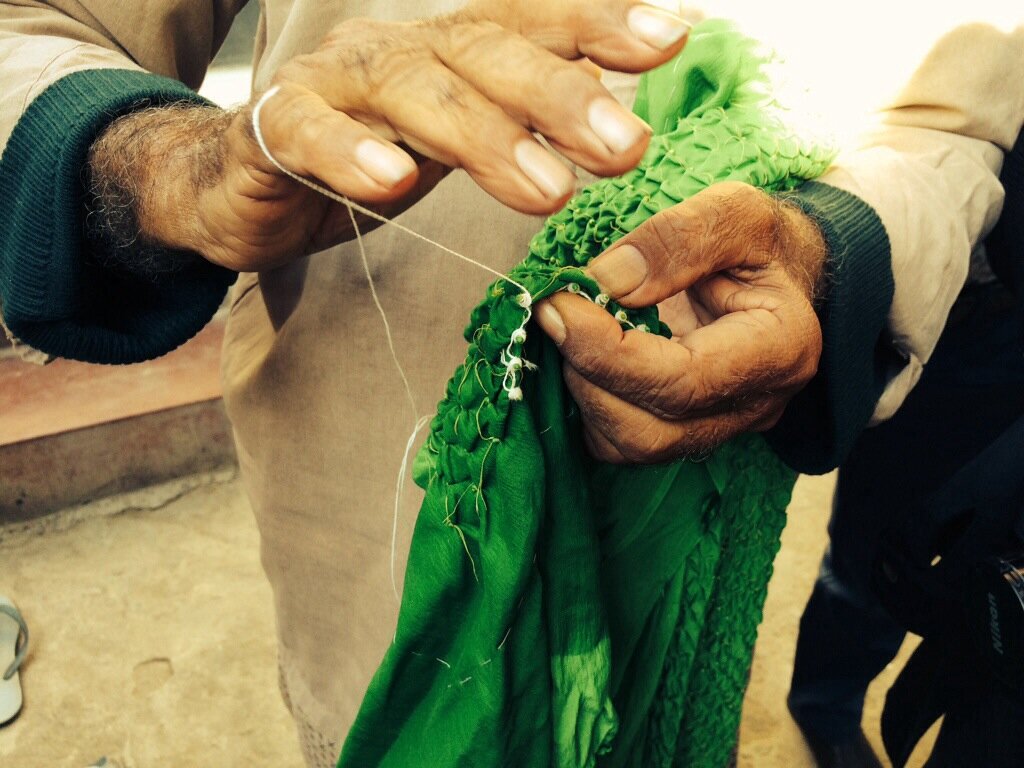
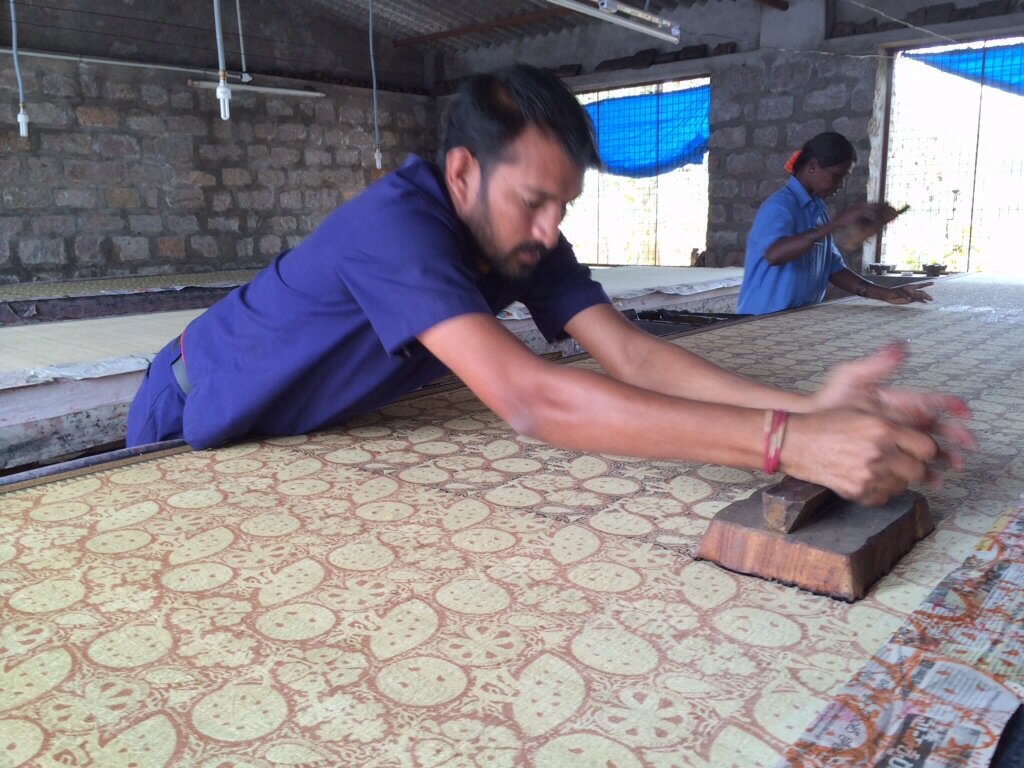 An entire family of weavers can work on a sari of gold, blue and red silk, all colored with natural dyes, made in a traditional design. The sari will spend the better part of six months on a loom, growing just inches a day, before being shipped off to a wealthy woman to wear to her daughter's wedding, and then to pack away as a family heirloom for her daughter to wear for her child's wedding. And then it will be passed along to the next generation.
An entire family of weavers can work on a sari of gold, blue and red silk, all colored with natural dyes, made in a traditional design. The sari will spend the better part of six months on a loom, growing just inches a day, before being shipped off to a wealthy woman to wear to her daughter's wedding, and then to pack away as a family heirloom for her daughter to wear for her child's wedding. And then it will be passed along to the next generation.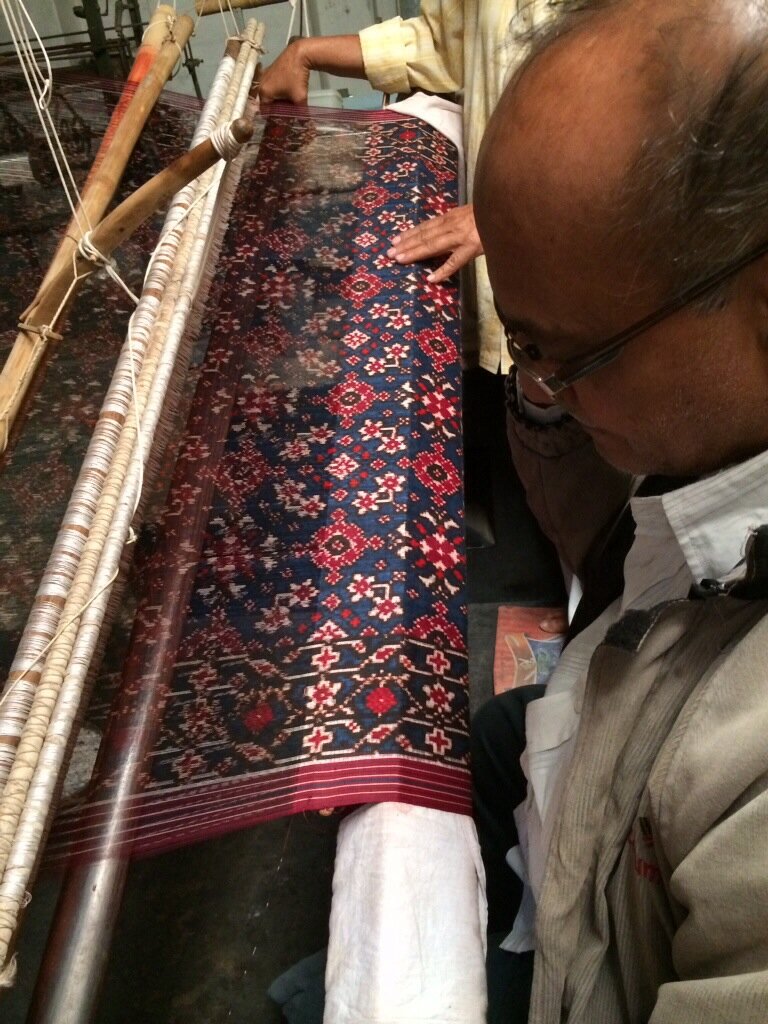 In many of these village we were told that the knowledge and skills used to create these masterpieces are in danger of disappearing. "People don't value the work of artists," was something we heard over and over. Young women who in the past would spend years hand embroidering a wedding trousseau that would became part of their dowry were now limited by the elders to a much shorter time so they could, instead, do work that would bring in more money for the family. Some people had begun using synthetic dyes instead of the natural ones that were traditional. Some weavers and silk screeners now use mechanized looms and presses instead of the hand looms and hand presses. It was jarring to hear at a cotton weaving factory the harsh clack of mechanical looms in one in room after just leaving a room, at the same facility, where the looms were operated by hand (actually by foot) and make a sound like flannel wrapped castanets.What struck each of us at every stop were the incredibly low prices attached to these treasures. We were seeing first hand what happens to the price of a stunning hand woven silk scarf when it leaves the village and ends up at Neiman Marcus. It wasn't budget, I am guessing, that reined in our desire to buy everything, but the serious charges for overweight on our flights that would have made anything we bought four times more expensive than what we would have paid.
In many of these village we were told that the knowledge and skills used to create these masterpieces are in danger of disappearing. "People don't value the work of artists," was something we heard over and over. Young women who in the past would spend years hand embroidering a wedding trousseau that would became part of their dowry were now limited by the elders to a much shorter time so they could, instead, do work that would bring in more money for the family. Some people had begun using synthetic dyes instead of the natural ones that were traditional. Some weavers and silk screeners now use mechanized looms and presses instead of the hand looms and hand presses. It was jarring to hear at a cotton weaving factory the harsh clack of mechanical looms in one in room after just leaving a room, at the same facility, where the looms were operated by hand (actually by foot) and make a sound like flannel wrapped castanets.What struck each of us at every stop were the incredibly low prices attached to these treasures. We were seeing first hand what happens to the price of a stunning hand woven silk scarf when it leaves the village and ends up at Neiman Marcus. It wasn't budget, I am guessing, that reined in our desire to buy everything, but the serious charges for overweight on our flights that would have made anything we bought four times more expensive than what we would have paid.